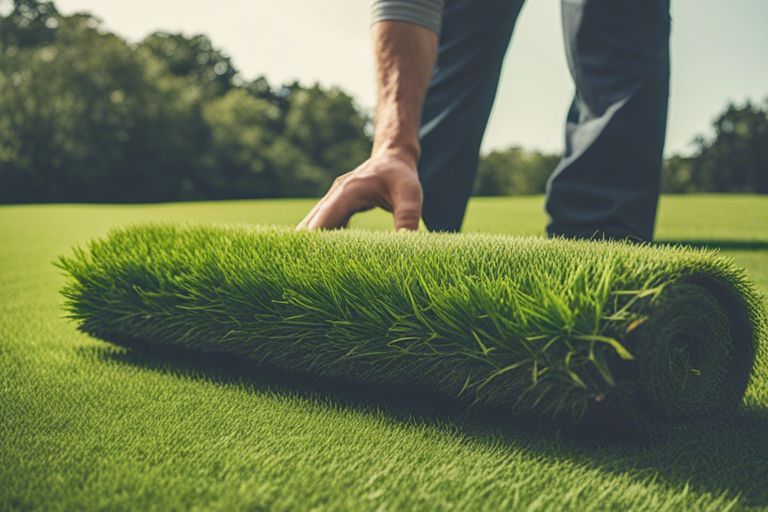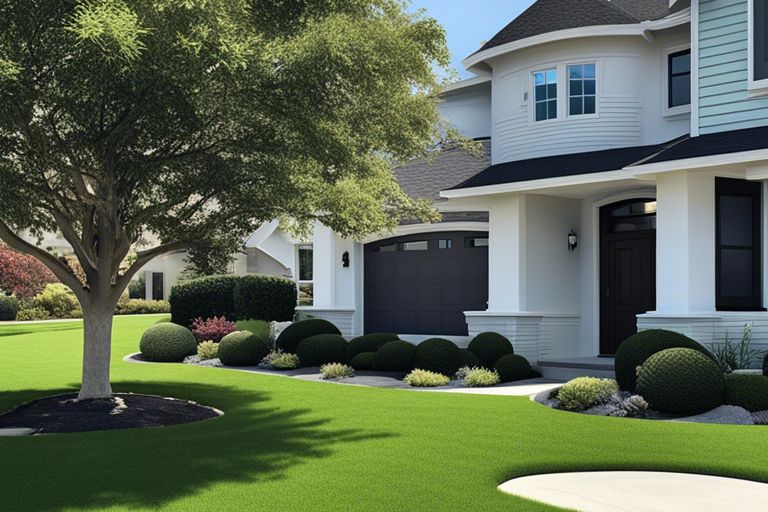With a little guidance, choosing the right type of grass for your yard can transform your outdoor space from drab to fab. You might find yourself wandering the aisles of your local garden center, contemplating whether to go for the robust Kentucky Bluegrass or the resilient Bermuda—both can make your lawn the envy of the neighborhood. In this guide, we’ll stroll through factors like climate, sun exposure, and the unique quirks of your locale to help you make an informed, oh-so-satisfying decision. After all, a healthy lawn is a happy lawn!

Key Takeaways:
- Climate Compatibility: Choose grass types that are well-suited for your local climate, such as warm-season grasses for southern regions and cool-season grasses for northern areas.
- Soil Conditions: Assess your soil type and quality; different grasses thrive in sandy, clay, or loamy soils, impacting overall growth and maintenance.
- Use Purpose: Consider the intended use of the lawn (e.g., high traffic areas vs. decorative spaces) to select grass that can withstand physical activity and visual appeal.
Climate Considerations
While choosing the right type of grass for your landscaping project, it’s imperative to keep your local climate in mind. Yes, that all too important element that seems to be doing more of the heavy lifting than your favorite pair of garden gloves. Understanding whether your region experiences warm or cool temperatures throughout the year will guide you in picking the grass that will thrive and avoid the embarrassing moment of looking out your kitchen window only to see a sad, patchy lawn reminiscent of a bad hair day.
Warm Season Grasses
The beauty of warm season grasses lies in their ability to flourish during the hotter months, typically from late spring through early fall. If you live in a region where the sun rules the skies and summer storms are a rare finding, this is your grass of choice. Varieties such as Bermuda and Zoysia are not only drought-resistant but also grow thick and lush, providing a vibrant green hue that can elevate your backyard aesthetic from ordinary to extraordinary.
These hardy grasses are not afraid to soak up those long, hot days, but they do have a shortcoming: they tend to turn brown once the temperatures cool off. So if you plan on showcasing your landscape through winter, be prepared to trade the verdant beauty for a dormant, golden palette. While this might sound like a hibernation for your lawn, remember it’s simply its way of conserving energy until the return of the balmy days.
Cool Season Grasses
Grasses like Kentucky Bluegrass and Fescue embody everything you adore about the refreshing chill of fall and spring. These cool season grasses are most happy when temperatures hover between 60°F and 75°F. If your locale experiences cold winters and mild summers, then you can confidently opt for these greens. They not only thrive in cooler weather but also boast impressive resilience to stressors such as drought and traffic—ideal for those of you who love entertaining in your outdoor spaces.
Cool grasses are truly a fascinating bunch. With their tendency to green up earlier in the spring and hold onto that luscious color longer into the fall, they might seem like the overachievers of the turf world. However, their performance can take a nosedive during the sweltering summer months, causing them to go into a temporary slumber. Understanding the balance between beauty and maintenance is crucial—if you live in a region with extremes, you may need to consider irrigation and other care techniques to keep your cool season grass looking its best. Do not forget, a little planning goes a long way in preserving your patch of green paradise!
Soil Type Matters
There’s no denying it: your soil can be your best friend or your worst enemy when it comes to choosing the right type of grass for your landscape. Understanding your soil type helps you avoid making disastrous choices, especially if you want a lush, green lawn that doesn’t resemble a neglected field. It’s crucial to know what you’re working with, so you can select grass blends that will thrive instead of wilt faster than a wilting daisy on a hot summer day.
Clay Soil
Soil that’s heavy on clay can seem like a cruel prank that Mother Nature has played on you. While it’s notorious for poor drainage and compaction, it’s also capable of holding onto nutrients quite well. Your challenge here will be in choosing grass varieties that can withstand these less-than-ideal conditions. Consider going for Bermudagrass or Zoysiagrass, both known for their resilience. But remember, if you plant something unsuitable, you might just find yourself in a not-so-great game of ‘Guess That Grass’ as it struggles to survive.
Be cautious though; while clay soil can retain moisture, it can become a swampy mess after heavy rains. If you’re in an area prone to flooding, you might want to think twice before opting for grass that isn’t built for such drama.
Sandy Soil
With sandy soil, you’re basically riding a roller coaster—at least you know you’re going to have a wild time. This type of soil drains quickly, and while that sounds great in terms of avoiding mud puddles, it also means nutrients wash away faster than your motivation after a long day. For sandy soil, consider varieties like Fescue or Perenial Ryegrass which are more tolerant of lower nutrient levels.
Soil amendments can also make a difference. You could add organic matter, such as compost, to help retain moisture and nutrients—a sort of lifeboat for your sandy shoreline. The trick is to strike a balance; you want the benefits of sandy soil without feeling like your lawn has turned into a petri dish of underachievement.
Loamy Soil
Matters of loamy soil are a bit of a gold star in the soil world! Often referred to as the “sweet spot,” loamy soil knocks it out of the park with its blend of sand, silt, and clay. This combination means you can expect good drainage while still being able to hold onto nutrients, which makes it perfect for a symphony of grass options. Consider varieties like Kentucky Bluegrass or Fine Fescue that thrive in these conditions.
Soil characteristics like pH levels and nutrient content can still affect your grass selection, so keeping a soil test kit on hand can be as imperative as that overpriced lawn gnome. If you’re fortunate enough to have loamy soil, you might just find that your grass grows like it’s auditioning for a role in a movie about the lushest lawns in the world!
Sandy soil blends beautifully with versatile grasses, but achieving that perfect balance can be a continuous effort. Regular maintenance, such as proper watering and fertilization routines, will keep your lawn looking like it’s just stepped off the runway at a lawn fashion week.
Sunlight and Shade
Keep in mind that one of the most critical factors in selecting the right type of grass in a landscaper’s roll for your locale is the amount of sunlight your lawn receives. Grass thrives in different light conditions, and understanding these can save you from the embarrassment of a patchy lawn that speaks louder than your neighbor’s power mower. For a comprehensive guide on what types of grass might work best where you live, check out this resource on Selecting the Right Grass for Your Region.
Full Sun Grasses
Sunlight is the darling of the grass world! Full sun grasses are those that flourish in at least six hours of direct sunlight each day. Think of them as the overachievers of the yard—a classic example includes Bermuda grass, which basks in the sun’s warm embrace and laughs at the mention of shade. If your lawn gets a healthy dose of sunlight, these breeds typically boast a vibrant green hue, resilient growth, and a texture that invites you to kick off your shoes and enjoy a leisurely picnic, though—let’s be honest—you’ll probably still be pickin’ dandelions.
Not only do full sun grasses require ample sunlight, but they also need regular watering and fertilization to achieve that lush, carpet-like finish. Compromising on any of these elements could result in weakened grass that quietly attempts to blend in with your neighbor’s “I-really-don’t-care” weedy patch. When picking your full sun grass, remember to keep a watchful eye on the **local climate**—sunny does not always mean scorching!
Partial Shade Grasses
Partial shade, on the other hand, is a whole different ballgame. Grasses that thrive in partial shade require a mix of sunlight and shade, often making them the diplomat of your landscape. These grasses prefer around three to six hours of sunlight and can still present a lovely lawn despite being sidelined by trees and buildings. Kentucky bluegrass is a popular option here; it revels in the breaks of sun while maintaining a vigorous appearance. Think of it as the charming acquaintance who excels in small talk while at a party of introverted ferns!
The beauty of partial shade grasses lies in their adaptability; they can still perform relatively well when they encounter light obstacles. However, **don’t let the name fool you**—even they will struggle if they’re denied the sunlight for too long. You’ll want to keep your eye out for **overhanging branches** that may cast too much shade and be vigilant about the watering needs—after all, a rolling stone gathers no moss, but too much moisture can certainly gather mold.
Deep Shade Grasses
Partial shade is the buzzword from before, but now we get to deepen the conversation—welcome to the land of deep shade grasses, where the sun’s rays barely make an appearance. These hardy grass types are specially adapted for areas where full sunlight is but a **fleeting dream**. If your yard is synonymous with gloom and despair, you might turn to the likes of fine fescue, which can somehow keep its sparkle amidst the shadows, making it the introvert of the grass world.
It is worth noting that while deep shade grasses may survive in low-light conditions, they will not thrive as enthusiastically as their sun-loving cousins. Their growth can be stunted, and they may not achieve that lush look you desire. So, if your yard is reminiscent of a cave, consider pairing these grasses with **strategic landscaping** to bring in a bit of light—perhaps some artistic pruning or even a well-placed garden bench to bask in the rays when they do finally show up!
Maintenance and Upkeep
Once again, you’ve chosen the perfect grass for your landscaping needs. But selecting the right type of grass is only half the battle; the other half involves providing the right maintenance and upkeep to ensure your lawn thrives in your specific locale. Whether you prefer a low-maintenance lawn that’s easy on your schedule or a more high-maintenance option that requires regular care, understanding what each grass type needs is crucial for a stunning outdoor space.
Low-Maintenance Options
With many homeowners juggling work, family, and social commitments, low-maintenance grass varieties can be a lifesaver. These grass types, like fescue or bermudagrass, are remarkable for their resilience with minimal intervention. They require less frequent watering and mowing, making them a great choice for those who prefer a more hands-off approach. With a few initial investments in weed and pest control, these grasses can thrive with little upkeep, leaving you to enjoy your lawn without the chore of constant attention.
What’s even better is that low-maintenance grasses are often more environmentally friendly, requiring less water and fertilizer. This means you not only cultivate a beautiful lawn but also contribute positively to your local environment. These options provide a smart solution for anyone looking to spend less time maintaining their yard while still achieving lush, green results.
High-Maintenance Options
With high-maintenance grass varieties, however, you’ll find the opposite is true. Types like Kentucky bluegrass or tall fescue offer a luxurious appearance and smooth texture but demand a little more from you in terms of regular care. These grasses typically require more frequent watering, regular mowing, and diligent weed and pest management. While they can yield exquisite results, you’ll need to adopt a routine that includes fertilizing, aerating, and even overseeding as necessary to keep them looking their best.
Low-maintenance grass options may be a great option for those looking to cut back on lawn work, but it’s undeniable that high-maintenance grasses have an allure that’s difficult to resist. The crisp, lush look and feel of a perfectly manicured lawn can be incredibly satisfying, particularly when the hard work pays off in the form of envy from neighbors and admiring glances from passersby.
Mowing and Watering Tips
The foundation of maintaining a beautiful lawn revolves around proper mowing and watering. With that in mind, knowing when and how often to mow your grass is crucial. It’s typically recommended to mow when your grass reaches about one-third above its ideal height. By doing so, you ensure that the grass remains healthy and your lawn maintains an even appearance. Additionally, frequent mowing can help prevent weeds and pests from becoming overwhelming.
- To maintain an even shape, consider using a sharp mower blade to produce clean cuts.
- Be mindful of watering times; early morning is your best friend.
- Adjust your mower height based on the season and type of grass.
- Rotate mowing patterns to minimize wear on your lawn.
Knowing these tips can significantly ease the maintenance burden on your lawn while enhancing its health and appearance.
To optimize your lawn care experience, focus on developing a consistent routine and keep an eye on changing weather conditions. Here are a few additional strategies to streamline your mowing and watering practices:
- **Set a schedule** that rotates between mowing and watering, keeping your grass at just the right height.
- **Invest in a rain gauge** to prevent overwatering and conserve water resources.
- **Consider using mulch** from cut grass to enrich your lawn.
Knowing these considerations can help keep your lawn vibrant while also contributing to its long-term health and resilience.
Drought Tolerance
Unlike the lush landscape you might envision with a classic garden, establishing a water-efficient yard means selecting the right type of grass that can handle periods of drought. Choosing a drought-tolerant variety can not only conserve water but also save you from the headache of a dying lawn during the hotter months. As climate change continues to alter our weather patterns, understanding drought resistance is necessary to keeping your lawn healthy and vibrant without needing a degree in hydrology.
Drought-Resistant Grasses
The majority of drought-resistant grasses are native to arid regions, which means they’ve developed a natural resilience to dry conditions. Kentucky bluegrass might claim the spotlight in traditional settings, but when you’re looking for that sweet spot of low maintenance and high survivability in dry spells, consider options like Bermuda grass or fine fescue. They thrive even when your landscape becomes a hot, sun-drenched oven—showing remarkable endurance through summer’s sizzle and leaving your neighbors green with envy.
Grasses for Water-Conscious Landscapers
The beauty of water-conscious landscaping lies in its practicality. When deciding on grasses for your lawn, think about varieties that are designed to gobble up the sun’s rays while sipping sparingly on your water supply. Zoysia is a prime contender here; it’s known for its dense growth and ability to stay lush with minimal irrigation. Plus, it snubs the weeds that try to crash your lawn party, which means more green and less brown!
Understanding the varying needs of grass types gives you a significant advantage as a gardener. By focusing on grasses that thrive in your locale’s unique climate, you can cultivate a lawn that not only survives but thrives, even in the face of a persistent drought. With proper planning, strategic watering practices, and the right selection of grasses, you can craft a landscape that is both beautiful and sustainable. The goal is to create a lush lawn that will conserve resources, and with drought-resistant options, you can save the planet too, one blade of grass at a time!
Pest and Disease Resistance
Your landscape is a reflection of your aesthetic style, but it’s also a battleground when it comes to keeping your grass thriving. This is especially true when it comes to pests and diseases that can wreak havoc on your beautiful lawn. In this section, we’ll explore not only the common threats you might encounter but also the resilient grasses that can withstand these attacks, and finally, we’ll arm you with effective strategies for integrated pest management. Because, let’s be honest, nobody wants their yard to look like a sad, neglected field from a low-budget horror film.
Common Pests and Diseases
Disease is often the uninvited guest at the garden party, creeping in when you least expect it—like a relative who shows up after you’ve already said your goodbyes. The most common culprits include grubs, chinch bugs, and fungal infections. Grubs snack on the roots of your precious grass, while chinch bugs are notorious for their insatiable hunger for the lush green blades you work so hard to maintain. Fungal diseases, meanwhile, can create unsightly patches that can make your yard look like it’s seen better days—because let’s face it, who wants a lawn that resembles a bad case of teenage acne?
These pests thrive in a variety of conditions, often making their moves during the warmest months. The telltale signs include brown patches, wilting, and (if you’re lucky) the faint crunch of grass underfoot. A vigilant eye can help you catch these nuisances early before they’ve made your lush landscape their personal buffet.
Grasses with Natural Resistance
Disease-resistant grasses are like the superheros of the lawn world, saving the day with their innate ability to shrug off problems that would leave less hardy varieties shaking in their boots. Popular options include Bermudagrass, which has a renowned toughness against a multitude of pests, and Kentucky bluegrass, noted for its resilience against certain diseases and its lovely, vibrant color. These natural champions reduce the need for chemical treatments, promoting a healthier environment while saving you time, effort, and possibly even a few dollars.
What’s exciting about these grasses is their adaptability and durability. They are engineered by nature to withstand local pests prevalent in your area, and they often require less water and fertilizer than more delicate varieties. After all, who wouldn’t want to cut down on maintenance while enjoying a thriving lawn, which makes you the envy of the neighborhood?
Integrated Pest Management Strategies
With all the potential threats out there, your strategy for managing these issues is crucial. Integrated Pest Management (IPM) is your best friend in this grass saga. It’s all about balance: combining cultural, biological, and chemical methods to control pest populations while minimizing the impact on your lawn and the environment. You’ll want to regularly monitor your grass to catch any issues early, and perhaps even enlist beneficial insects to do some of the heavy lifting in controlling those pesky pests.
IPM isn’t a one-size-fits-all approach; it’s tailored to what you’ve got going on in your yard. By carefully considering your local ecosystem, you can develop a plan that not only protects your grass but also fosters a more resilient environment that can withstand the trials of Mother Nature.
Pest management is a necessary evil in lawn care, particularly when you aim for that picture-perfect landscape. Knowledge is your greatest weapon, as understanding the lifecycle of pests and their natural enemies can make all the difference. A little bit of planning and awareness will ensure that your grass stays vibrant and healthy, rather than a reluctant participant in nature’s survival of the fittest. So, gear up and take charge; the luscious lawn of your dreams is closer than you think!
Summing up
Considering all points, choosing the right type of grass for your landscape can feel like an overwhelming task, akin to selecting the perfect cheese for a charcuterie board—after all, no one wants to end up with the stinky blue cheese when they were aiming for a delightful brie! The key lies in understanding your locale’s climate, soil conditions, and, let’s not forget, how much maintenance you’re willing to embrace (because let’s be real, who has time for a demanding lawn?). Whether you’re drawn towards the lushness of Kentucky Bluegrass or the resilience of Zoysia, you’ll want to ensure your choice aligns not just with the aesthetics of your yard, but also with the realities of your environment.
As you launch on this grassy journey, remember that it’s about more than just the grass; it’s about creating a harmonious relationship between your home and the vibrant life that awaits just outside your door. With a bit of research and perhaps a friendly chat with your local nursery, you can strike the perfect balance between beauty and practicality. So, go ahead—choose wisely, and soon enough, you’ll be the proud owner of a sod masterpiece that even Mother Nature would nod in approval!
Q: What factors should I consider when choosing the right type of grass in a landscaper’s roll for my area?
A: When dicking out the right type of grass for your locale, consider factors such as climate, soil type, sunlight exposure, and water availability. Different grass species have varying tolerance levels to heat, cold, drought, and shade. For example, cool-season grasses thrive in northern climates with cold winters, while warm-season grasses are better suited for southern regions with hot summers. Additionally, test your soil’s pH and nutrient levels to determine what type of grass will flourish in your specific soil conditions.
Q: How do I determine the best grass type for my yard’s sun and shade conditions?
A: Assessing your yard’s sun and shade patterns is crucial in choosing the right grass type. Observe how many hours of sunlight your garden receives daily. Full-sun grasses typically require at least 6-8 hours of direct sunlight, while shade-tolerant varieties can thrive in areas that receive less light. Depending on these conditions, opt for sun-loving grasses like Bermuda or Zoysia for sunny areas, while fescue or ryegrass would be more suitable for shaded locations. This will ensure that the grass thrives and remains healthy throughout the seasons.
Q: What is the importance of local climate in grass selection, and how can I find the best type for my region?
A: Local climate plays a significant role in grass selection, as different grasses have varying growth patterns and requirements based on temperature and moisture levels. Research your USDA Plant Hardiness Zone, which provides guidance on the best types of grass for your climate. Additionally, consulting local landscaping professionals or extension services can offer valuable insights into which grass varieties are well-adapted to your specific region. This information will help ensure that you select a grass type that can withstand the local climate challenges and thrive year-round.


